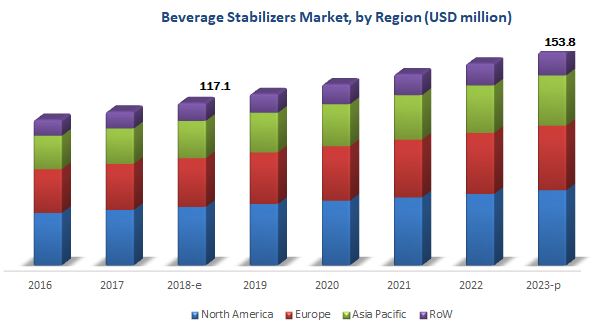The ongoing COVID-19 pandemic—and the worldwide reaction to it—has compelled companies to radically rethink their strategies and the way they operate. We salute the industry experts helping companies survive and sustain in this pandemic.
At MarketsandMarkets™, analysts are undertaking continuous efforts to provide analysis of the COVID-19 impact on the Brewing Enzymes Market. We are working diligently to help companies take rapid decisions by studying:
- The impact of COVID-19 on the Beverage Stabilizers Market, including growth/decline in product type/use cases due to the cascaded impact of COVID-19 on the extended ecosystem of the market
- The rapid shifts in the strategies of the Top 50 companies in the Beverage Stabilizers Market
- The shifting short-term priorities of the top 50 companies’ clients and their client’s clients
You can request an in-depth analysis detailing the impact of COVID-19 on the Beverage Stabilizers Market: https://www.marketsandmarkets.com/speaktoanalystNew.asp?id=87923328
The report “Beverage Stabilizers Market by Type (Xanthan Gum, Carrageenan, Gum Arabic, and CMC), Function (Stabilization, Texturization, and Viscosification), Application (Fruit Drinks, Dairy Products, and Soft Drinks), and Region – Global Forecast to 2023″, The beverage stabilizers market is estimated at USD 117.1 million in 2018 and is projected to reach a value of USD 153.8 million by 2023, at a CAGR of 5.6%. The growth of the beverage stabilizers market is driven by the rising demand for healthier and natural food ingredients from the food industry. The key drivers for the market’s growth are the rise in beverage consumption, the multi-functionality of beverage stabilizers, and the growth in the use of natural ingredients in foods due to increasing consumer awareness about healthy diets.

Objectives of the study are as follows:
- To define, segment, and measure the beverage stabilizers market with respect to its type, application, function, and region
- To provide detailed information about the major factors influencing the growth of the market (drivers, restraints, opportunities, and industry-specific challenges)
- To analyze the complete value chain and supply chain of beverage stabilizers
- To analyze the opportunities in the market for stakeholders and provide details of the competitive landscape for market leaders
- To profile the key players and comprehensively analyze their core competencies
- To analyze the competitive developments-new product developments, mergers & acquisitions, investments, expansions, joint ventures, collaborations, and supply contracts-in the beverage stabilizers market
- To profile the key beverage stabilizers companies with respect to the business overview, recent financials, segmental revenue mix, geographic presence, and information about the products & services
Download PDF Brochure:
https://www.marketsandmarkets.com/pdfdownloadNew.asp?id=87923328
The worldwide demand for beverage stabilizers is on the rise, particularly in the fruit drinks industry. The demand is governed by the performance quality and functionality of the products. Increasing demand for beverage stabilizers is one of the factors supporting market development and significant innovation.
The global market is segmented on the basis of application into fruit drinks, dairy products, soft drinks, alcoholic beverages, and others (which include tea & coffee and sports & energy drinks). The fruit drinks dominated the beverage stabilizers market; this segment accounted for the largest share in 2017. The increasing range of applications of stabilizers in the beverage industry is expected to fuel their demand for beverage stabilizers during the review forecast period. The dominance of this segment can be attributed to the increasing R&D investments from food ingredients companies and ongoing research for vaccinations.
The market is segmented on the basis of function into stabilization, texturization, viscosification, and others such as emulsification, thickening, and anti-crystallization. Beverage stabilizers prevent sedimentation, degradation, and turbidity during beverage processing and provide stability to beverages.
On the basis of the type, the global market is segmented into xanthan gum, carrageenan, gum arabic, carboxymethyl cellulose (CMC), and others include pectin, guar gum, and locust bean gum. Xanthan gum is used as a stabilizer, thickener, suspending agent, and emulsifier. It is widely used as an additive in gluten-free products, owing to its better binding characteristics in comparison to other food additives such as guar gum and locust bean gum.
Make an Inquiry:
https://www.marketsandmarkets.com/Enquiry_Before_BuyingNew.asp?id=87923328
The North American region is estimated to form the largest market for beverage stabilizers in 2018. North American consumers are considered to be more health-conscious and pay close attention to the ingredients used in the food products and medicine they consume. The demand for natural food ingredients influences the buying behavior of key food & beverage manufacturers in the market. The potential demand for beverage stabilizers is further driven by the foodservice industry in the region.
This report includes a study of marketing and development strategies, along with the product portfolios of the leading companies. It includes profiles of leading companies such as Cargill (US), Tate & Lyle (UK), DowDuPont (US), Ashland (US), Palsgaard (Denmark), Glanbia Nutritionals (US), Kerry Group (Ireland), Advanced Food Systems (US), Chemelco International (Netherlands), and Nexira (France).
Targeted Audience:
- Food & beverage suppliers and manufacturers
- Food & beverage importers and exporters
- Food & beverage traders and distributors
- Government and research organizations
- Associations and industry bodies [World Health Organization (WHO), ICBA (International Council of Beverage Associations), American Beverage Association (ABA), and Global Food & Beverage Association (GFBA)]